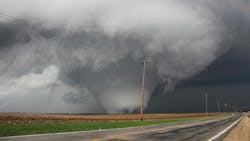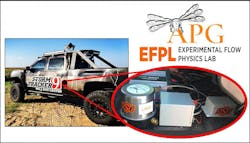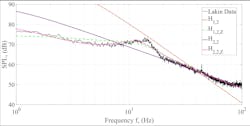Tornadogenesis Identified with Infrasound—New Predictions Possible
For more tornado-related technology, check out "Storm-Chaser Reed Timmer’s Rocket-Propelled Probe Breaks New Twister Science."
What you’ll learn:
- Details of tornadoes and infrasound frequency detection.
- Design aspects of the GLINDA system.
- How GLINDA can be used for early warning systems.
“My mind was racing with a million thoughts, regrets, prayers, etc., but I still noticed the pressure change and could feel air from under the door as it blew in towards me, then sucked back out of the room. I heard things slamming into my house, then the sheetrock overhead fell down and it sounded like my roof lifted and came back down. I heard the sound of nails being pulled out of wood, glass breaking, and then the scariest sound I've ever heard, and pray that I never hear again. It was a groan. A moaning. And I can only describe it as evil. It caused me to shake head to toe, and that shaking continued on from April 12 until the day I met my girlfriend in early August.” That’s how Adam Taylor (via NOAA), a resident of Cleveland, Tenn., described the sounds he heard while taking shelter in his house as a tornado took it apart in April of 2020.
There are many stories just like his, and each year throughout the U.S., more are added. According to the National Oceanographic and Atmospheric Administration’s (NOAA) Storm Prediction Center, during May 2024, there were 570 tornadoes reported. That’s significantly more than double the 1991-2020 average of 268.4 tornadoes for the month of May, and the highest count on record, surpassing the 550 tornadoes of May 2003.
While Doppler radar does a good job of tracking and predicting where tornadoes could form, it doesn’t provide a complete picture of their lifecycle. Storm spotters and chasers have learned to recognize certain thunderstorm features and structures that make tornado formation more likely, and they often work with the NOAA by reporting what they see. Some of these are visual cues, like the rear-flank downdraft, and others are patterns in radar images, such as tornadic vortex signatures.
More recently, scientists have taken an unconventional approach to detecting where and how tornadoes will form using sound. It could lead to a new type of early warning system that might save more lives.
Listening to Tornadogenesis
Scientists have been listening to tornadoes for decades, trying to figure out if they produce a unique sound signature during or after a formation. Surprisingly, some experiments have shown that low-frequency infrasound, with a frequency range of 1 to 10 Hz, is produced during tornadogenesis—the birth of a tornado—and the course of its life.
In 2020, scientists from Oklahoma State University managed to grab evidence that a twister produced a specific, elevated signal between 10 and 15 Hz using infrasound microphones. Those same scientists hope that by listening to those noises, they could detect tornadoes up to two hours before they form.
The science team, headed by Dr. Brian Elbing, associate professor of mechanical and aerospace engineering at OSU, has been testing infrasound’s prospective powers using specially designed equipment stored in their storm-chasing vehicle. Known as GLINDA (Ground-based Local INfrasound Data Acquisition), the system (Fig. 1) was designed around a Raspberry Pi 3B+.
GLINDA Gets Put to the Test
GLINDA uses an off-the-shelf Adafruit Industries ADS1115 infrasound microphone that provides a sensitivity of 401 mV Pa−1 at 1 Hz and a flat response from 0.1–200 Hz to within −3 dB. It also packs an inertial measurement unit (IMU), a Global Positioning System (GPS) receiver, and an analog-to-digital converter (ADC) that’s connected to the analog output of the infrasound microphone. All of the data collected by the system is time-stamped and stored locally.
To listen to infrasound in the atmosphere, the scientists equipped GLINDA within the cab of their chase vehicle, which was powered by 1500-W inverters that also powered the vehicle’s other weather observation systems. They also took advantage of a small port on the roof of the vehicle for the GPS antenna to be routed outside of the cab for improved connectivity.
The moment of truth came to test GLINDA on May 22, 2020, when a storm produced a tornado near Lakin, Kansas. According to the science team, they arrived at the intercepting location for the tornadic storm system approximately 2 to 5 minutes prior to tornado formation. They managed to successfully deploy their system and garner data on the tornado as it happened in real-time.
How Did GLINDA Perform?
According to the collected data, the tornado lasted 13 minutes, had a length of nearly 2 miles, and a maximum damage path width of 137 meters (and unknown strength). The storm chasers measured this system from 2.5 miles SSE of the tornado, where the data showed an elevated signal during the tornado spanning 10 to 15 Hz (Fig. 2), which is consistent with previous observations of small tornadoes.
Their results also showed a consistency of the mobile observations with fixed measurements, meaning the GLINDA system is accurate and capable of collecting data during tornadogenesis, albeit if the system is positioned close enough to storm activity. But that’s the name of the game for weather scientists and storm chasers.
The science behind GLINDA was sound enough to be included in the 2023 movie Supercell, written and directed by Jamie Winterstern. It follows a young son looking to bring meaning to his father’s unfortunate death while chasing tornadoes. Before his death, the son’s parents were developing a “heartbeat device” that could detect the birth of a tornado using infrasound, which was based on the GLINDA system and supported by Brian Elbing.
Want me to review Supercell? Already done… more soon.
About the Author
Cabe Atwell
Technology Editor, Electronic Design
Cabe is a Technology Editor for Electronic Design.
Engineer, Machinist, Maker, Writer. A graduate Electrical Engineer actively plying his expertise in the industry and at his company, Gunhead. When not designing/building, he creates a steady torrent of projects and content in the media world. Many of his projects and articles are online at element14 & SolidSmack, industry-focused work at EETimes & EDN, and offbeat articles at Make Magazine. Currently, you can find him hosting webinars and contributing to Electronic Design and Machine Design.
Cabe is an electrical engineer, design consultant and author with 25 years’ experience. His most recent book is “Essential 555 IC: Design, Configure, and Create Clever Circuits”
Cabe writes the Engineering on Friday blog on Electronic Design.



